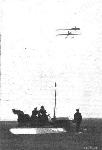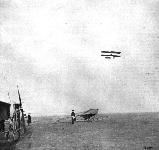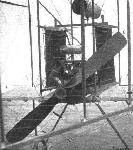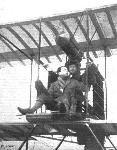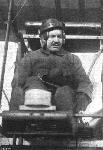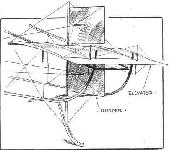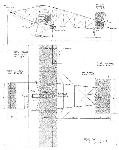
Описание
Страна: Великобритания
Год: 1910
.
S.Ransom, R.Fairclough English Electric Aircraft and their Predecessors (Putnam)
Howard Wright Curtiss-pattern Biplane
During the latter part of 1910, Howard Wright completed a single 35 hp-engined pusher biplane on the lines proposed by Glenn Curtiss, of the USA. No drawings or photographs of the aircraft have survived and it must be presumed that Howard's design incorporated the predominant features of a Curtiss biplane of the period, namely mid-gap ailerons and a tricycle undercarriage. In other respects the Curtiss machine resembled the Howard Wright 1910 Biplane.
Span 33 ft; wing area 270 sq ft.
Howard Wright 1910 Biplane
The last and most successful aircraft built by Howard Wright to W.O. Manning's design were the 1910 Biplanes. On many occasions there were likened to and confused with the Farman Biplane but in detail design and workmanship they were incomparable. Further recognition of the attributes of the 1910 Biplane was achieved through the exploits of its pilots, who found it pleasant to fly and tolerant of mishandling.
The aircraft closely followed the pattern for a two-seat pusher biplane introduced by Farman and emulated by many others, with the pilot and passenger seated in tandem in an exposed position over the leading-edge of the lower wing and in front of the engine. Initial versions of the machine were fitted with a 60 hp ENV vee-eight water-cooled engine, its radiators flanking the passenger, but at a later date the aircraft were fitted with a 50 hp Gnome rotary engine. Propellers of Howard Wright manufacture were fitted to all 1910 Biplanes.
The parallel-chord wings were built up on two spars, one spar being positioned along the leading-edge and the other at the aileron hinge line. Both spars were braced along their length with wires passing through the apexes of small sheet-steel inverted-V posts. The upper wing could be increased in area by detachable extensions braced from a kingpost at the leading edge near the joint. Ailerons were mounted on all four wingtips and the extensions when fitted, and were operated from a column placed at the pilot's right-hand side. The pilot's control column was connected, also, to the forward elevator which in turn was linked directly to the tail elevator, and the split rudder was pedal operated. The monoplane tail, built and braced in a similar manner to the wings, could be adjusted on the ground for changes of trim and was carried, like the forward elevator, on four wire-braced booms. The bracing wires in the region of the propeller however, were prevented from flying about, in the event of breaking or coming adrift, by being tied at intervals to cords running parallel with them. The undercarriage was the accepted arrangement of wheels and skids. A large proportion of the airframe was made from Honduras mahogany, ash being used only in the undercarriage and for the rudder post. Fittings were made from cast aluminium and steel and where attachments had to be made the wooden parts were locally reinforced with steel plate. Although production of the biplane was continuous over a period of about a year and each machine was constructed to a common pattern, no two aircraft were identical, modifications being made to suit the customer's individual needs.
The biplane, fitted with upper wing extensions, made its debut at Larkhill, Salisbury Plain, during August 1910, piloted by Lieut E.M. Maitland, who had qualified for his brevet in France. Shortly after taking delivery of the machine, Maitland crashed it at Larkhill. His injuries prevented him making further flights but he had the machine repaired and lent it to his brother officer, Lieut H.E. Watkins, so that he could learn to fly. Watkins took the aircraft to Brooklands and there used it to qualify for his Royal Aero Club Aviator's Certificate, No.25, on 15 November 1910. On his first circuit of Brooklands, Watkins flew with Manning as his passenger. In December, Watkins took the biplane to Shorncliffe, near Folkestone, to compete for the Baron de Forest prize but the aircraft was wrecked before he could start. The biplane had been fitted with an automatic wireless transmitter so that Watkins' flight could be tracked by Maitland from a tug, equipped with a receiver as they crossed the English Channel. After repairs, the biplane was flown on a number of occasions before Maitland sold it to the War Office for ?625 on the opening day of the 1911 Olympia Aero Show. It was officially taken on charge on 23 June, 1911, and given the serial number F3. The aircraft served with No.2 Company, the Air Battalion of the Royal Engineers, at Larkhill, and accumulated 1 hr 56 min flying time before becoming unserviceable on 8 July, 1911. In the following January, it was taken to the Royal Aircraft Factory, Farnborough, and used, ostensibly, in the construction of the B.E.6, serial number 206.
After the sale of Maitland's biplane, Watkins bought another of the same type from John Dones, better known as 'Jack Dare', who was the brother of the then well-known actress sisters, Zena and Phyllis Dare. Dones' biplane was the second to be built and was delivered to him at Eastchurch at the end of September 1910. This aircraft was also owned at a later date by W.D. Johnstone.
The third 1910 Biplane brought the type into prominence through the exploits of its pilot, T.O.M. Sopwith. Sopwith's machine arrived at Brooklands in November 1910, from Eastchurch. The morning of 21 November saw Sopwith attempting a few straight flights without having taken any instructions on handling, and in the afternoon he made a number of circular flights, which included three to qualify for Aviator's Certificate No.31. Three days later, and with only ten hours flying to his credit he entered the biplane for the British Empire Michelin Cup competition for the longest nonstop flight by a British pilot in a British machine. Sopwith's flight from 10.15 am to 1.18 pm covering 107 miles not only set up new British records but also put him in a strong position to win the prize. The next two weeks were spent in modifying the ENV-powered standard pattern biplane for longer flights. The modifications included: adding upper wingtip extensions with ailerons; fitting a large-capacity petrol tank in place of the passenger's seat; the addition of a fabric-covered fairing for the pilot's protection; and repositioning the control column to between the pilot's legs. On 18 December, the Baron de Forest prize was Sopwith's with a flight of 169 miles in 3 1/2 hr from Eastchurch to Beaumont in Belgium. Sopwith's biplane also gained the distinction of being the first all-British aircraft to be flown across the English Channel. As 1910 drew to a close Sopwith set out to improve his time for the Michelin Cup and on 31 December, the last day of the contest, established a new record of 4 hr 7 min 17 sec with a flight of 150 miles 246 yards. However, the prize was not to be his, S.F. Cody claimed it at the last moment with a flight of 195 miles in 4 hr 50 min.
On 1 February, 1911, Sopwith flew his biplane to Windsor Castle at the invitation of HM King George V, a journey made from Brooklands in thick mist and intense cold. In April, the biplane was displayed on the Royal Aero Club's stand at the Olympia Aero Show before being taken by Sopwith in the following month, to the USA. Sopwith's tour of the USA proved extremely successful, many passenger-carrying, demonstration and stunt flights being made interspersed with competitive flying. The tour, however was not without mishap, the biplane being wrecked on two occasions; at Columbus, Ohio, on 3 June, when Sopwith skimmed low over a field and the starboard undercarriage skid dug into a small hillock, and near Manhattan Beach, on 10 September, when the engine failed and Sopwith and his passenger came down in the sea. The biplane was repaired after both accidents! On his return from the USA, Sopwith established a school of flying at Brooklands and used the biplane for training, for which role it had been fitted with dual control in March 1912.
The next ENV-powered biplane was exported unassembled to New Zealand in 1910. It had been bought by two Auckland brothers, Leo and Vivian Walsh with the backing of an enthusiastic syndicate. They, with the aid of their sisters, completed the biplane late in 1910 and, after initial tests during which Vivian Walsh had to teach himself to fly, the biplane was given its first public demonstration before New Zealand's prime minister at Papakura on 5 February, 1911. About a year later, the biplane was taken over by W.S. Miller and F.E. Sandford, who rebuilt and modified it to have sweptback outer-wing panels and a semi-enclosed cockpit. The biplane was tested in its new form at Avondale Racecourse, Auckland, in February 1913. It subsequently made a number of successful flights but was finally written-off after a crash at Alexandra Park, Auckland, on 6 December, 1913. The only other biplane, fitted with an ENV engine, known to have been flown abroad was that owned by W. C. England at Rangoon during the summer of 1912.
At home, the 1911 Olympia Aero Show heralded a new variant of the biplane. Although it followed the original pattern, the layout was adaptable for racing for which purpose it had been built for Robert Loraine, the Irish actor who had achieved fame with his crossing of the Irish Sea in the previous September. The biplane was powered by the 50 hp Gnome rotary engine salvaged after the crossing from Loraine's Farman racing biplane, and it was the first time that this type of engine had been used in any Howard Wright machine. To adapt the aircraft for racing the lower wings could be reduced in span by removing their outer sections. This was accomplished simply by releasing ten bracing wires, undoing two bolts and removing two struts from their sockets at each wingtip. Alterations to the controls were avoided by the fitting of broad-chord ailerons only to the upper wing. The only other noticeable difference a minor one, was the fitting of undercarriage skids which had their forward portions more upturned than usual. After the Show the aircraft was flown at Brooklands.
The second Gnome-powered biplane, also a racing pattern was bought by Claude Grahame-White, who flew it during the latter part of 1911 at Hendon. During 1912 Grahame-White used the biplane for training at his newly established flying school and at which, on 6 June, no less than six pilots used it to qualify for their aviator's certificate, among them No.231 awarded to Marcus Dyce Manton, who was later to become chief test pilot and inspector to the English Electric Co. The others were: H.C. Biard, F.H. Fowler, T.O'B. Hubbard, R.T. Gates and Lieut B.T. Janes. Two weeks later N.S. Roupell and E.H. Morriss gained their brevets. The last to qualify on the biplane was R.H. Kershaw on 16 July. In the meantime Grahame-White had married Dorothy Taylor, whom he had met in New York. On this occasion the biplane was flown by the bridegroom to the reception held at Sir Daniel Gooch s mansion, Hylands, at Widford in Hertfordshire. Seven days later, on 6 July, the biplane was flown by Lewis Turner to win the speed handicap race at Hendon. In July, also, Turner crashed the biplane at Harlow, Middlesex.
The last two biplanes to be built were entered for the ?10,000 Daily Mail Circuit of Britain race and the second Michelin Cup competition respectively. The former machine was fitted with upper wing extensions, a small bluff fairing in front of the pilot and 60 hp Green engine. It was flown by Lieut H.R.P. Reynolds who, although delayed by previous competitors for the race, made a good start in the evening of Saturday, 22 July, 1911. Reynolds landed at Hendon that night. He spent Sunday adjusting the engine to give more power and making several circuits to test its performance. On Monday he rejoined the race, reaching Doncaster by nightfall. Reynolds arrived at Harrogate the next day but there was forced to retire from the race. J.L. Longstaffe, the pilot of the other machine fared little better, his attempts at the Michelin Cup being thwarted by mechanical trouble.
Records show that Capt G. Ll. Hinds Howell and one Louis de Silva also piloted the biplane at Brooklands during 1910. Production of the biplane, however, ceased with the sale of Howard Wright's aircraft interests to the Coventry Ordnance Works.
1910 Biplane (Standard pattern)
Span 36 ft; span upper wing with extensions 48 ft; length 36 ft 6 in; height without wing extensions 12 ft; wing chord 6 ft 6 in; gap 6 ft 6 in; aileron span 6 ft 6 in; extension aileron span 6 ft; aileron chord 1 ft 6 in; forward elevator span 8 ft 6 in; forward elevator chord 3 ft; tailplane span 12 ft; tailplane chord including elevator 5 ft 6 in; elevator span 12 ft; elevator chord 1 ft 6 in; rudder height each 2 ft 6 in; rudder chord each 3 ft; propeller diameter 8 ft; propeller pitch 4 ft 8 in; wing area including ailerons 454 sq ft; wing area with extensions including ailerons 532 sq ft; total aileron area 39 sq ft; total aileron area with extensions 57 sq ft; forward elevator area 25.5 sq ft; tailplane area including elevator 66 sq ft; elevator area 18.5 sq ft; total rudder area 15 sq ft.
Weight empty 800 lb; weight loaded 1,200 lb.
Maximum speed 45 mph; cruising speed 36 mph; endurance 5 hr.
Price ?1,000.
1910 Biplane (Racing pattern)
Span upper wing 36 ft; span lower wing 22 ft; length 37 ft; wing chord 6 ft; gap 6 ft.
Описание:
- S.Ransom, R.Fairclough English Electric Aircraft and their Predecessors (Putnam)
- H.King Sopwith Aircraft 1912-1920 (Putnam)
- M.Goodall, A.Tagg British Aircraft before the Great War (Schiffer)
- P.Lewis British Aircraft 1809-1914 (Putnam)
- Журнал Flight
Фотографии
-
P.Lewis - British Aircraft 1809-1914 /Putnam/
Howard Wright Biplane with 50 h.p. Gnome and broad-chord ailerons.
-
S.Ransom, R.Fairclough - English Electric Aircraft and their Predecessors /Putnam/
'Jack Dare' with his Howard Wright 1910 Biplane, the second built, at Eastchurch in October 1910.
-
P.Lewis - British Racing and Record-breaking Aircraft /Putnam/
Capt E. M. Maitland's Howard Wright biplane at Brooklands, flown by Lieut H. E. Watkins in the 1910 contest for the L4,000 Baron de Forest prize.
-
S.Ransom, R.Fairclough - English Electric Aircraft and their Predecessors /Putnam/
Lieut Maitland's and Lieut Watkin's Howard Wright 1910 Biplane on the occasion of being handed over to the Air Battalion of the Royal Engineers.
-
S.Ransom, R.Fairclough - English Electric Aircraft and their Predecessors /Putnam/
T. O. M. Sopwith's Howard Wright 1910 Biplane undergoing repairs to an aileron at Brooklands.
-
Журнал - Flight за 1910 г.
Mr. Sopwith, on his E.N.V. engined Howard Wright biplane, after his record flight.
-
Журнал - Flight за 1910 г.
Half-side view of the Howard Wright biplane.
-
Журнал - Flight за 1912 г.
Mr. W. C. England on his E.N.V.-englned Howard Wright biplane at Rangoon, Burma, where he has been introducing aviation at the Rangoon Golf Club at Mingaladon.
-
Журнал - Flight за 1910 г.
THE HOWARD WRIGHT BIPLANE. - Side view of Mr. Sopwith's E.N.V. engined machine, on which he flew from the Royal Aero Club's Eastchurch grounds to Belgium on Sunday.
-
Журнал - Flight за 1910 г.
Front view of the Howard Wright biplane, with Mr. Sopwith in the pilot's seat.
-
Журнал - Flight за 1911 г.
Rear view of the Howard Wright biplane.
-
M.Goodall, A.Tagg - British Aircraft before the Great War /Schiffer/
The Howard Wright racing biplane shown at Olympia in 1911 was fitted with a Gnome rotary instead of the usual ENV.
-
M.Goodall, A.Tagg - British Aircraft before the Great War /Schiffer/
The Howard Wright biplane with which T. O. M. Sopwith won the L4,000 Baron de Forest prize on 18 December, 1910. Tom Sopwith used his Howard Wright biplane very successfully in Britain and America.
-
Журнал - Flight за 1911 г.
The Howard Wright biplane, which will be steered by Lieut. Reynolds in the Daily Mail Circuit of Great Britain.
-
Журнал - Flight за 1912 г.
Mrs. Stocks just before starting for a flight in the Howard Wright biplane at Hendon last week-end is introduced to the Daily Mirror's "Baby Jumbo," but unfortunately (?) Mrs. Stocks already had the passenger seat occupied, and Jumbo therefore was not invited for a spin.
-
S.Ransom, R.Fairclough - English Electric Aircraft and their Predecessors /Putnam/
Howard Wright 1910 Biplane bought and assembled by the Walsh brothers at Auckland New Zealand, in 1911.
-
Журнал - Flight за 1912 г.
THE WEEKLY FLYING MEETINGS AT HENDON. - Mr. Lewis Turner on the Howard Wright just getting away in the cross-country handicap.
-
Журнал - Flight за 1910 г.
Mr. Sopwith in flight in the mist on his Howard Wright biplane.
-
Журнал - Flight за 1910 г.
BRITISH RECORD FLIGHT. - Mr. Thomas Sopwith, on his Howard Wright biplane, completing his 90th mile at Brooklands. Note the score board which conveyed to the flyer, mile by mile, his distance traversed.
-
Журнал - Flight за 1910 г.
Lieut. Watkins, on his Howard Wright biplane, flying over the troops at Shorncliffe during his trips preparatory to trying for the Baron de Forest L4,000 Cross-Channel Prize.
-
Журнал - Flight за 1911 г.
Mr. T. Sopwith, the winner of the Baron de Forest L4,000 Prize, on his E.N.V.-engined Howard Wright biplane during his second attempt at Brooklands for the British Michelin Prize. Note the old method of locomotion, the automobile stuck in the mud being assisted by the original "h.p.'s."
-
Журнал - Flight за 1911 г.
Lieut. Watkins flying well at Brooklands on Saturday last on Capt. Maltland's "No.2" Howard Wright.
-
Журнал - Flight за 1911 г.
AT BROOKLANDS ON SATURDAY. - Tom Sopwith in flight on his Howard Wright, and the Spencer-Stirling machine on the ground.
Другие самолёты на фотографии: Spencer biplane - Великобритания - 1910
-
Журнал - Flight за 1911 г.
CARS AND FLYING AT BROOKLANDS. - Brooklands has now become quite a centre of activity by reason of the flying attractions daily in operation there. Two pictures, taken on Saturday last, above give some idea of the gatherings which assemble day by day around the actual flying village. In the upper photograph Mr. Tom Sopwith is flying his E.N.V.-engined Howard Wright biplane, one of the very successful Bristol machines being seen to the right. In the bottom picture Mr. Low, one of the expert pilots of the Bristol Co., is making one of his fine flights round the aerodrome.
Другие самолёты на фотографии: Bristol Boxkite - Великобритания - 1910
-
Журнал - Flight за 1911 г.
Mr. Low, on his Bristol biplane, getting well into the air at Brooklands. At rest are Mr. Sopwlth's Howard Wright biplane, and in the distance the Hanriot monoplane.
Другие самолёты на фотографии: Bristol Boxkite - Великобритания - 1910Hanriot monoplane - Франция - 1910
-
Журнал - Flight за 1911 г.
A PASSENGER FLIGHT AT BROOKLANDS. - Lieut. Watkins, with a passenger, on Mr. Maitland's Howard Wright biplane, making one of his graceful flights past the hangars. At temporary rest is the Weiss monoplane.
Другие самолёты на фотографии: Weiss No.2 Sylvia - Великобритания - 1910
-
Журнал - Flight за 1912 г.
Mr. Lewis Turner finishing first and Mons. Verrier second in the second heat of the Speed Handicap at Hendon on Saturday last.
Другие самолёты на фотографии: Maurice Farman MF.7 Longhorn - Франция - 1912
-
Журнал - Flight за 1911 г.
BROOKLANDS AS SEEN FROM ABOVE. - A view when passing over the flight colony at Brooklands Aerodrome on Mr. Tom Sopwith's Howard Wright. Note the "magnetic" sewage farm on the left, and in the far distance the motor test hill, finishing straight, &c.
-
Журнал - Flight за 1911 г.
BROOKLANDS AS SEEN FROM ABOVE FROM MR. TOM SOPWITH'S HOWARD WRIGHT BIPLANE. - Passing over the winding Wey and the Brooklands Club House. Note the bridge across the Wey leading to the aviation grounds.
-
Журнал - Flight за 1912 г.
Guests at Mr. Claude Grahame-White's wedding at Sir Daniel Gooch's residence, "Hylands," watching Mr. B. C. Hucks flying on his Bleriot during the afternoon. On the ground in front of the mansion is Mr. Grahame-White's Howard Wright biplane on which he flew over, and on the right is the Aircraft Co.'s Maurice Farman biplane on which M. Verrier during the afternoon gave some remarkable exhibitions in a strong wind.
Другие самолёты на фотографии: Bleriot Bleriot-XI-2 - Франция - 1911Maurice Farman MF.7 Longhorn - Франция - 1912
-
Журнал - Flight за 1911 г.
BY THE KING'S COMMAND. - Mr. Tom Sopwith's visit to Windsor Castle on his E.N.V.-engined Howard Wright biplane on Wednesday of last week, in response to an invitation from King George to fly over from Brooklands. King is seen (X) shaking hands with Mr. Sopwith immediately after landing in front of the terrace.
-
Журнал - Flight за 1910 г.
View from behind of the central portion of the Howard Wright biplane, showing the propeller, E.N.V. engine, Spiral Tube.Co.'s radiators, &c.
-
Журнал - Flight за 1910 г.
Tail details of the Howard Wright biplane.
-
Журнал - Flight за 1911 г.
UNDER-CARRIAGES AT OLYMPIA. - The typical Farman-Wright type as built by Howard Wright.
-
H.King - Sopwith Aircraft 1912-1920 /Putnam/
T. O. M. Sopwith seated in the 60 hp Howard Wright biplane which was just beaten by the Cody biplane in the 1910 Michelin Cup No.1 event, wherein he began to feel that he was 'a really experienced pilot.'
-
S.Ransom, R.Fairclough - English Electric Aircraft and their Predecessors /Putnam/
T. O. M. Sopwith seated at the controls of his modified Howard Wright Biplane with which he won the #4,000 Baron de Forest prize for the longest flight into Europe.
-
Журнал - Flight за 1910 г.
Mr. Thomas Sopwith in the pilot's seat of his Howard Wright biplane, fitted with E.N.V. engine, after creating a new British record for distance and duration by his flight at Brooklands Aerodrome on Saturday of 107 3/4 miles in 3h. 12m. 55s.
-
Журнал - Flight за 1910 г.
Mr. Sopwith takes up his sister, Miss May Sopwith, for a flight at Brooklands on his Howard Wright machine.
-
S.Ransom, R.Fairclough - English Electric Aircraft and their Predecessors /Putnam/
Lieut H. E. Watkins.
-
Журнал - Flight за 1910 г.
Lieut. Hugh E. Watkins, who is flying his E.N.V.-engined Howard Wright biplane in the Baron de Forest L4,000 Cross-Channel Prize contest.
-
Журнал - Flight за 1911 г.
Lieut. Watkins, with Mr. Cecil Pashley as passenger, just prior to a flight at Brooklands last Saturday on Capt. Maitland's "No.2" Howard Wright.
-
Журнал - Flight за 1912 г.
Lieut. B. T. James, who qualified for his pilot's certificate on a Howard Wright at Hendon on June 1st after the fourth day only in an aeroplane.
-
Журнал - Flight за 1912 г.
Baroness Schenk, one of the lady aviators who are practising at Hendon Aerodrome.
-
Журнал - Flight за 1912 г.
How Grahame-White's School Howard Wright biplane appeared after it had dashed into trees. Apart from the broken elevator, splintered propeller, two or three ribs smashed, and a damaged tail tip, no further damage was done.
-
Журнал - Flight за 1912 г.
MR. C. HEMIN'S BLERIOT AND HOWARD WRIGHT MODELS. - The latter is fitted with a compressed-air motor with which some good flights have been obtained.
Другие самолёты на фотографии: Bleriot Bleriot-XI - Франция - 1909
-
Журнал - Flight за 1910 г.
Sketch of the tail of the Howard Wright biplane showing elevator and rudder.
-
Журнал - Flight за 1911 г.
Sketch showing the arrangement of the framework at the tail of the Howard Wright machine.
-
Журнал - Flight за 1911 г.
UNDER-CARRIAGES AT OLYMPIA. - A comparison in tail skid construction.
Другие самолёты на фотографии: Bleriot Bleriot-XIbis / Bleriot-XIV - Франция - 1910Bristol monoplane - Великобритания - 1911Martin & Handasyde Model 2/3/4 - Великобритания - 1910
-
Журнал - Flight за 1911 г.
MONOPLANES AND BIPLANES IN THE DAILY MAIL CIRCUIT ROUND GREAT BRITAIN. - From these every machine can be readily identified either in flight or on the ground.
-
S.Ransom, R.Fairclough - English Electric Aircraft and their Predecessors /Putnam/
Howard Wright 1910 Biplane (Sopwith's Aircraft).
-
P.Lewis - British Aircraft 1809-1914 /Putnam/
Howard Wright Biplane
-
Журнал - Flight за 1910 г.
THE HOWARD WRIGHT BIPLANE. - Elevation and plan to scale.



















